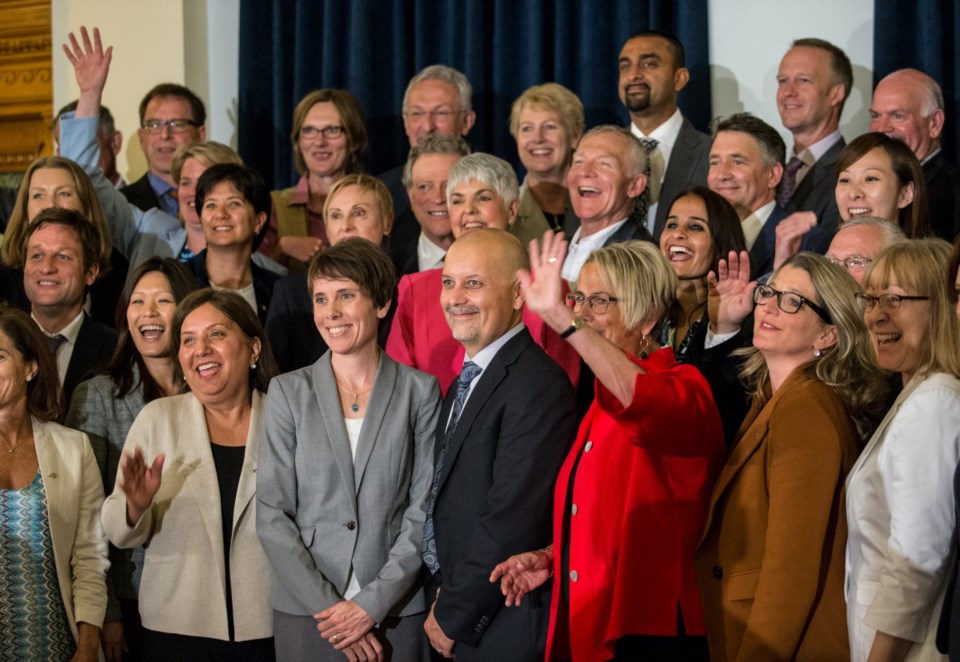 When B.C.’s Greens agreed to back the NDP this week, they got the top-of-the-Christmas-list gift they wanted: action on electoral reform.
When B.C.’s Greens agreed to back the NDP this week, they got the top-of-the-Christmas-list gift they wanted: action on electoral reform.
Not the direct imposition of some form of proportional representation, mind you. No, jamming a major change like that down voters’ throats would have led to an HST-style grassroots revolt.
Instead, the accord signed by all 41 New Democrat and three Green MLAs Tuesday merely promises a referendum in conjunction with the November 2018 civic elections.
It was the brass ring the Greens — for whom prop-rep represents a way to translate popular vote into seats in the legislature — really needed from the NDP during this rare window of opportunity.
Maybe we shouldn’t be surprised that the Greens won the promise: After all, such a referendum was already in the New Democrats’ campaign platform (even if some doubted the depth of their commitment to the idea).
In fact, the entire Green-NDP deal covers areas where the two were largely on the same page anyway.
And that, in turn, shows how inevitable the Weaver-Horgan bromance was. They simply had too many positions in which they were in agreement, and too many in which they opposed Liberal policy, for it to go any other way.
The accord details 10 pages of actions the Greens and NDP agree to take, should the New Democrats lead the next government. Among the points:
• They’ll introduce a bill in the first sitting of the next session making good on all those pre-election promises to ban big money from politics. No more corporate or union donations or donations from non-residents of B.C. Individual contributions will be capped.
Both parties vowed such changes during the campaign (though cynics wondered if the labour-backed NDP would make them a priority).
• They’ll do everything they can to fight the Kinder Morgan pipeline expansion.
• The Site C dam won’t be shelved, as the Greens wanted, but the project will be referred to the B.C. Utilities Commission for review of its economic viability, as the NDP promised. Construction will continue while the review takes place — but it’s worth noting that B.C. Hydro has already delayed the demolition of a couple of homes that were scheduled to be razed.
• Both caucuses will support the adoption of the UN Declaration on the Rights of Indigenous Peoples and the recommendations of the Truth and Reconciliation Commission.
• There will be tougher lobbying rules, including a multi-year ban preventing senior public office holders from morphing into lobbyists soon after leaving government.
• An arms-length commission will plot a path to a minimum wage of at least $15 an hour.
• There’s no specific mention of $10 day care, but there is a commitment to invest to increase the quality, affordability and accessibility of child care.
• Cabinet will have a fully fledged minister for mental health and addictions.
• A fentanyl crisis response will be “based on successful programs that invest in treatment-on-demand, drug substitution, early-warning monitoring systems and co-ordinated response.”
• The first NDP budget will include a program designed to reduce the cost of prescription drugs.
• Medical Services Plan premiums will be phased out.
• The carbon tax will rise by $5 a tonne each year, beginning next April. About 80 per cent of residents will get rebate cheques.
• Provincial elections will be shifted to October from May to allow the passage of budgets. That means the next election (unless the minority government falls) will be in October 2021.
There’s a lot of other stuff included in the Green-NDP document — and a lot of bits that are noticeable by their absence. There’s no specific mention of fracking or LNG, for example, or of ferries. There’s no express mention of ride-hailing services like Uber, though Tuesday afternoon NDP Leader John Horgan spoke of his distaste for the idea of a California-based company sucking away money at the expense of those who have invested heavily in the B.C. taxi industry. “To have that evaporate overnight is not the best way forward.”
New Democrats say not to read much into any exclusions from the Green-NDP document. The party campaign platform is still the blueprint they plan to follow. The fact they didn’t need to deviate from it to win Green support shows how close the two parties always were.



